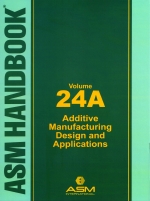Tab Article
The new Volume 24A provides a comprehensive review of additive manufacturing (AM) design fundamentals and applications. The primary focus of the Volume is on metallic systems with limited emphasis on polymers and ceramics where applicable.
- The first five divisions provide an in-depth review of each of the key aspects of the entire AM value chain.
- The materials/process development division discusses AM process-structure-property relationships, process optimization and defects, and material/process modeling.
- The design principles division includes coverage of design rules, part consolidation and assemblies, and simulation-driven design.
- In the data management division, data analytics, data security, and data sharing through a common data model are discussed.
- Next, the mechanical property division section includes discussion on fatigue, tensile, hardness, and other property testing.
- The AM non-destructive evaluation (NDE) division discusses surface and geometrical characterization, ultrasonic testing, radiography, computed tomography, and resonant ultrasound spectroscopy. Included in the AM in-situ process control and monitoring division are articles on machine learning for anomaly detection, in-process thermography, laser powder-bed fusion process control, and in-situ x-ray imaging.
- The applications division reviews key sectors that are embracing and adopting AM technologies. The market sectors are aviation, space flight, medical, automotive, oil and gas, construction, energy, and electronics.
- The last two divisions cover AM standards, qualification, and certification, as well as environmental, economic, and business concerns.


